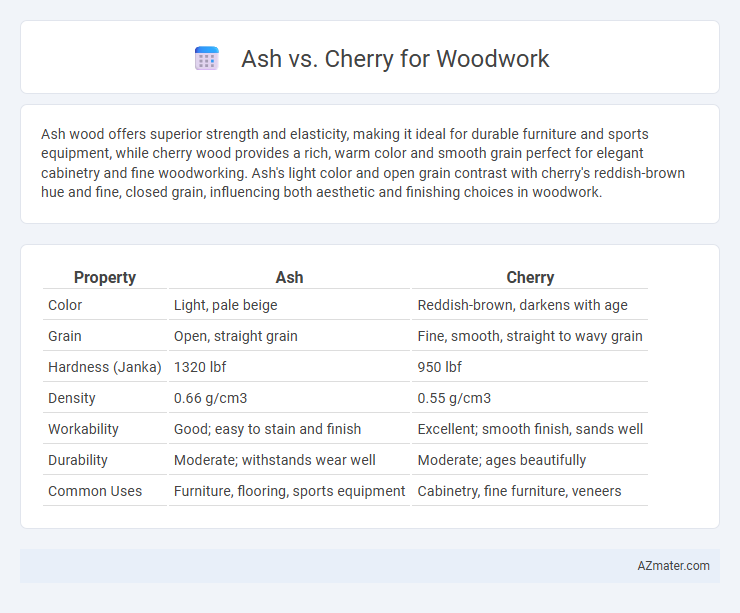Ash wood offers superior strength and elasticity, making it ideal for durable furniture and sports equipment, while cherry wood provides a rich, warm color and smooth grain perfect for elegant cabinetry and fine woodworking. Ash's light color and open grain contrast with cherry's reddish-brown hue and fine, closed grain, influencing both aesthetic and finishing choices in woodwork.
Table of Comparison
| Property | Ash | Cherry |
|---|---|---|
| Color | Light, pale beige | Reddish-brown, darkens with age |
| Grain | Open, straight grain | Fine, smooth, straight to wavy grain |
| Hardness (Janka) | 1320 lbf | 950 lbf |
| Density | 0.66 g/cm3 | 0.55 g/cm3 |
| Workability | Good; easy to stain and finish | Excellent; smooth finish, sands well |
| Durability | Moderate; withstands wear well | Moderate; ages beautifully |
| Common Uses | Furniture, flooring, sports equipment | Cabinetry, fine furniture, veneers |
Introduction: Comparing Ash and Cherry Wood
Ash wood offers exceptional strength and light color, making it ideal for sturdy furniture and sports equipment, while cherry wood is prized for its rich, warm tones and fine grain, perfect for elegant cabinetry and detailed woodworking. Ash tends to be harder and more shock-resistant, suitable for items requiring durability, whereas cherry darkens beautifully over time, enhancing its aesthetic appeal in indoor applications. Both woods differ significantly in grain pattern and workability, influencing their choice based on project requirements and desired finish.
Botanical Origins and Growth Patterns
Ash wood originates from trees in the genus Fraxinus, thriving in temperate regions with rapid growth patterns that produce straight, tall trunks ideal for woodworking. Cherry wood comes from Prunus species, particularly Prunus serotina, exhibiting slower growth with dense grain and rich reddish hues valued in fine furniture. Both species demonstrate distinct botanical traits influencing grain texture and durability, with Ash favored for strength and flexibility, while Cherry is prized for smooth finishing and color depth.
Appearance: Color, Grain, and Texture
Ash wood features a light, creamy to pale brown color with a straight, pronounced grain pattern that provides a classic, rustic appearance ideal for woodwork. Cherry wood offers a rich, warm reddish-brown hue that deepens over time, complemented by a fine, smooth texture and subtle grain variations that add elegance and sophistication. Both woods exhibit durability, but Ash's coarse texture contrasts with Cherry's silky finish, influencing choice based on desired aesthetic and tactile qualities in woodworking projects.
Workability and Machining Properties
Ash wood offers excellent workability with its straight grain and uniform texture, making it easy to cut, shape, and sand for various woodworking projects. Cherry wood, prized for its smooth texture and fine grain, machines cleanly and holds detail well, providing a polished finish with minimal effort. Both woods respond well to hand and power tools, but ash generally exhibits greater toughness, while cherry's natural oils enhance tool glide and reduce wear.
Durability and Strength: Ash vs Cherry
Ash wood exhibits exceptional durability and strength, making it a prime choice for heavy-duty woodworking projects and furniture that endure frequent use. Cherry wood, while also strong, is slightly softer than ash but offers excellent resistance to wear and a smooth finish that improves with age. The higher density and shock resistance of ash make it preferable for applications requiring robust structural integrity.
Finishing and Staining Capabilities
Ash wood offers a smooth grain that absorbs stains well, resulting in a vibrant, uniform finish ideal for intricate woodworking projects. Cherry wood naturally darkens with age and exposure, producing a rich, warm patina that enhances its smooth texture without requiring heavy staining. Both woods respond differently to finishing: ash accepts a wider variety of stains for customizable colors, while cherry's inherent warmth often benefits from clear finishes that highlight its natural reddish tones.
Cost and Availability Factors
Ash wood generally offers a more affordable option compared to cherry wood, making it a popular choice for budget-conscious woodworkers. Ash is widely available across North America, which contributes to its lower cost and easy procurement for various woodworking projects. Cherry wood, known for its rich color and fine grain, is often pricier due to limited availability and slower growth rates, impacting overall cost and accessibility.
Common Woodworking Applications
Ash wood is widely favored in woodworking for its strength, shock resistance, and attractive grain, making it ideal for furniture, flooring, and tool handles. Cherry wood is prized for its rich, reddish-brown color and smooth texture, commonly used in cabinetry, fine furniture, and decorative veneers. Both woods offer durability and workability, with ash suited for structural projects and cherry preferred for aesthetic, high-end finishes.
Sustainability and Environmental Impact
Ash wood is highly sustainable due to its fast growth rate and widespread availability, making it a renewable resource for woodworking projects. Cherry wood, while prized for its rich color and grain, grows more slowly and often requires careful forest management to ensure environmental sustainability. Choosing ash over cherry reduces ecological impact by supporting quicker growth cycles and minimizing the strain on forests, aligning with eco-friendly woodworking practices.
Choosing the Right Wood: Ash or Cherry
Ash wood offers exceptional strength and shock resistance, making it ideal for furniture and flooring that require durability and impact absorption. Cherry wood provides a rich, warm color that deepens over time, lending elegance and smoothness suitable for fine cabinetry and detailed woodworking. Choosing between ash or cherry depends on whether you prioritize robustness and light color with ash or the aesthetic appeal and smooth texture of cherry for your woodwork project.

Infographic: Ash vs Cherry for Woodwork
 azmater.com
azmater.com